
It is widely known that machine learning is as good as the data that we input in it. We often use an extremely large dataset to teach the machine learning model to differentiate between the identified datapoints. That is called training data.
Before we go through training data, it is worth mentioning that in machine learning, there are three types of machine learning datasets: training, test, and validation.
2 types of training data: Labeled data and unlabelled data.
1. Labeled data
Is used for supervised machine learning models. The data is tagged, labeled, or annotated by humans according to the defined criteria so that the particular machine learning model can produce the desired output.
Labeled data also can even have more than one label depending on the set criteria.
For example, an image of a "drink can" could be assigned more than one tag; can, crushed can, drink can. This way, the machine is able to learn all the attributes of the particular image that are relevant to the model.
The process or as we called it data annotation is a very time-consuming and also expensive to do. That is why Tictag offers you a painless, affordable and high-quality alternative. With an average of 99.5%+ accuracy as proof, we ensure that you get data annotated and labelled according to YOUR criteria. Talk to us today and redeem your first 100 labelled data points for free.
2. Unlabelled data
Is quite opposite of labeled data. We feed the machine learning model with raw data and let the model learn the pattern by itself. No human tagging is involved in unlabelled data.
If we used the drink example, then the model will evaluate the images based on their characteristics and in this case its shape. After dozens of images being fed into the model, the model should then be able to recognise the difference between those drinks.
There are also hybrid models which combine both supervised and unsupervised machine learning.
After learning the differences between labeled and unlabelled data now arises the question:
"How do we know that our training data is GOOD?"
What makes Good Training Data?
There are two important elements any good training dataset must have:
Relevancy
The data used must be related to the objective of the machine learning model and the items it learns from. You don’t want to use a picture of cars on a highway for your model to learn the differences between various types of drinks.
Focus on the dataset that’s related to your defined criteria.
Consistency
With consistent data, You will likely have a high accuracy model in the testing phase. For example, the label used for specific characteristics is consistent throughout the entire dataset. This can be managed by simple tasks such as making sure the bounding boxes are always tight and the quality of the image is constant.
Employing these two methods would ensure high consistency and even higher accuracy.
Garbage in, garbage out
It is very easy and common to find low-quality data for a cheaper price or lesser resources. The question now stands, do you really want to feed this data to your machine learning or AI models, only to get inaccurate and inefficient results?
The world of Artificial Intelligence very strictly follows the “Garbage in, garbage out” notion. That is why you may want to feed your machine only very high-quality data to obtain high accuracy output or result.
As of right now, there are lots of open-source datasets that you can find online. So in case you want to train your model on specific cases, you might want to search it up online first before you start making your own dataset to save yourself some time.
Remember to find alternatives that best suit your data and your AI/Machine Learning/Data Science/ Computer Vision project and model.
Tictag provides a free consultation session - our experts would love to walk you through the customised, highly-accurate and quick data annotation process that YOUR data can benefit from! Book your session today!




